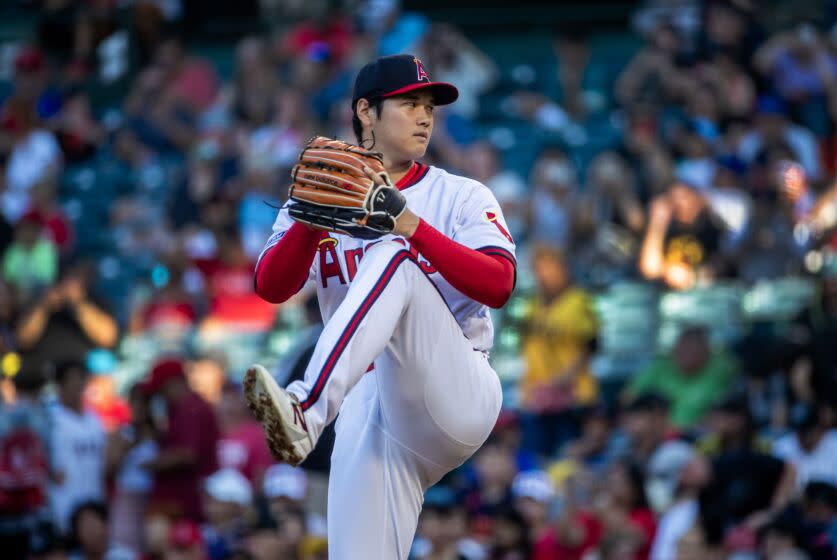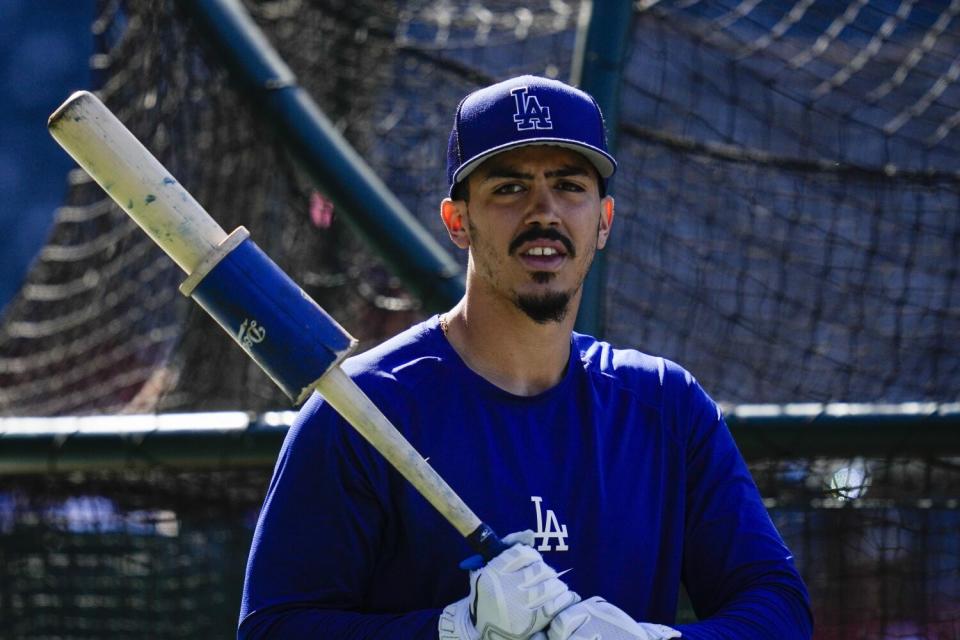
At the time, it felt like one of the biggest steals in recent trade deadline memory.
Max Scherzer and Trea Turner for a couple of prospects who, despite their high ceilings, were mostly surplus talent at the time of the transaction? It was a deal that made obvious sense for the Dodgers at the 2021 deadline. And it’s still seen as a good value now, even after Scherzer and Turner failed to help deliver a title to Los Angeles.
However, as with most big deals like it in baseball, there comes a time when the bill is due.
For the Dodgers, that time is now. Approaching the Aug. 1 deadline, they are short in a couple of key areas.
Read more: Inside the Dodgers’ juggernaut farm system, the lifeblood of the club
And suddenly, the loss of pitcher Josiah Gray and catcher Keibert Ruiz — the centerpieces of the Scherzer/Turner trade from the Dodgers’ farm system — are being ever so precariously felt.
Such is the fraught nature of team-building in Major League Baseball, where contending clubs like the Dodgers walk a fine line between preserving their future competitive outlook while maximizing their present title chances.
Under president of baseball operations Andrew Friedman, it’s a balance the club has mostly been able to find. While they’ve been to the playoffs for 10 straight seasons, they’re placed among the top 10 in Baseball America’s farm system rankings nine straight times. While they’ve run club-record payrolls to acquire superstar big league talent, they’ve cycled from one homegrown nucleus to the next, successfully retooling their MLB roster on the fly.
Still, in the days, weeks and months ahead, the organization could face one of its toughest tests yet — one that can be just as important to building and maintaining a farm system as drafting and developing players is.
They have a long shopping list of not-so-subtle needs: Starting pitching depth is a must, with the addition of a true front-line arm looking more and more necessary. The bullpen could use a few more options, given the inconsistent performance of the current group. The lineup would benefit from one more dependable bat, preferably from the right side of the plate.
Beyond this season, however, more questions abound — an expected pursuit of two-way star Shohei Ohtani, and the potential half-billion dollar contract he is expected to sign in free agency this winter, chief among them.

So, should the Dodgers stay the course and retain their best young pieces, or look for a big splash that could cost them several top prospects?
A week out from the deadline, It’s a question Friedman and the front office have encountered before.
“I think that’s a question each and every deadline,” Friedman said. “Obviously we’ve done a good job at [replenishing the farm system] over the last nine, 10 years. It’s just something we’ve never thought about in a way of being flippant about. Our mindset is to never take that for granted.”
That said, the Dodgers haven’t been afraid of blockbuster trades before, trading away, in Friedman’s estimation, “more good young players than anyone over the last eight years.”
For the most part, the Dodgers have come out ahead in those deals. A few years ago, one rival scout said, they were developing a reputation for “constantly destroying other clubs” in player swaps.
In hindsight, though, not even they have always gotten that part of that equation right.
For every Willie Calhoun, Yusniel Diaz, and Jeter Down — ultimately disappointing top prospects dealt in blockbuster deals for Yu Darvis, Manny Machado and Mookie Betts, respectively — there is a Yordan Álvarez, an Oneil Cruz, a Gray and a Ruiz.
Álvarez, the Houston Astros’ star designated hitter, and Cruz, the Pittsburgh Pirates’ promising young shortstop, were flipped as young prospects more than a half-decade ago in deals for Josh Fields and Tony Watson, respectively. Their futures, at that time, were still largely unclear.
Gray and Ruiz were different; newly debuted big leaguers who were headed for likely productive careers, but not quite ready to make a major impact on the 2021 Dodgers team.
Those are the kind of prospects the Dodgers have in bundles right now, from pitchers like Bobby Miller, Ryan Pepiot, Emmet Sheehan and Gavin Stone, to position players like Diego Cartaya, Michael Busch and Miguel Vargas. All of them could be coveted at this year’s deadline. And any of them might be needed to swing a deal in a market expected to have more buyers than sellers.
Refusing to part with them could hamper the Dodgers’ chances to win this season — even as they hold the second-best World Series odds entering Monday, according to Fangraphs computer models.

Giving up too much young talent at the deadline, though, could carry its own repercussions in upcoming seasons.
For most of the past year, the Dodgers have signaled an expected interest in Ohtani this offseason. Their front office filled out their roster with mostly expiring contracts, leaving roughly $95 million to come off the books this winter. Players and staff members have privately speculated about the American League MVP front-runner, as well, many hopeful the team checks all the boxes in its potential list of landing spots on the open market.
“If he wants to come,” Betts said during the All-Star Game, while mic’d up on the Fox broadcast with teammate Freddie Freeman, “he’s more than welcome.”
The only problem is that signing Ohtani would leave the Dodgers with precious little financial flexibility. Ohtani, Betts and Freeman combined could make close to $100 million annually. And this offseason, the Dodgers might have holes at second and third base, left and center field and all across the pitching staff if Julio Urías and/or Clayton Kershaw leave.
This is where the Dodgers farm system comes into play.
The more young options they have at each position, the better odds one of them will emerge as a low-cost, highly productive big leaguer to balance out their future teams (maybe with Busch one day taking over at third, or some combination of young pitchers providing the rotation a backbone as soon as next year?)
It’s partially what kept the team from making a big splash at last year’s trade deadline, when the Dodgers’ 111-win team could have benefited from another starting pitcher.
And it’s a dynamic they could very well face again — building up another impressive stock of young talent to only now decide whether the bird in hand is truly worth two in the bush.
“We know the prices are going to be more than what our rational brain would say makes sense,” Friedman said. “But, we’ve made a number of deadline deals [in past seasons]. And we’re pretty good at suspending rational thought for that moment in time. So we’ll continue to operate that way. Now, there’s a limit to that. But we’re expecting that if we’re able to make trades, we’re trading away some really good young parts.”
Read more: Meet the Dodgers double-A rotation, the epitome of their ‘ridiculous’ pitching pipeline
Developing more young parts is something the Dodgers have proven proficient at. Even if they part with top prospects at this year’s deadline, they could put faith in their ability to reload the pipeline again, trusting that their player development machine can churn out another generation of talent before long.
Still, it’s no easy calculation, an imperfect tension pulling between their present and future.
The Dodgers have once again built a formidable farm system. Now comes an equally difficult part, deciding exactly how to utilize it in pursuit of another World Series.
Sign up for more Dodgers news with Dodgers Dugout. Delivered at the start of each series.
This story originally appeared in Los Angeles Times.